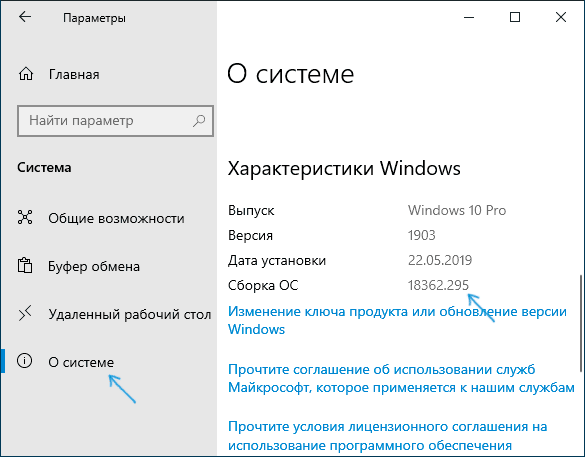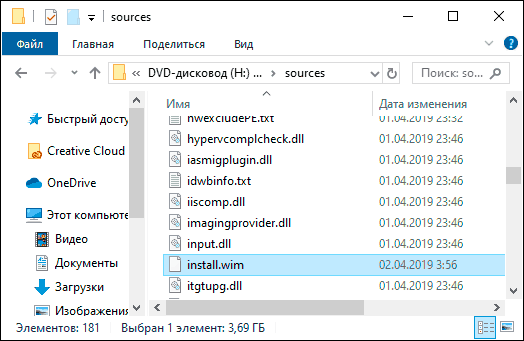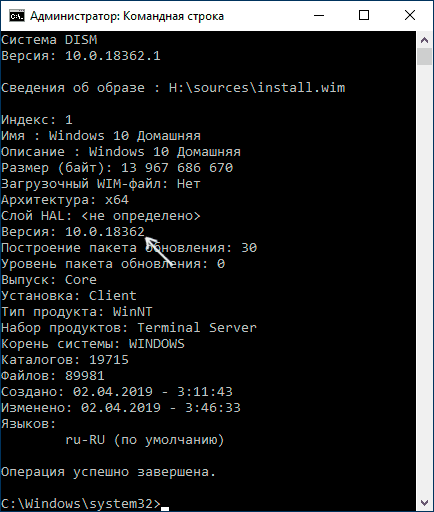В этой статье рассмотрим, как с помощью DISM и PowerShell разобраться, какие образы Windows (версии, разрядности, редакции, языки) хранятся в ISO или WIM файлах. И если в имени ISO файла не указана версия и билд, то сложно понять какая версия Windows находится внутри. В этом случае проще всего придется смонтировать ISO файл с установочным образом Windows и получить данные из установочного файла install.wim.
Щелкните по ISO образу правой клавишей и выберите Mount.
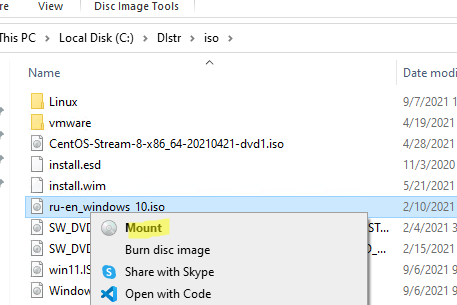
Перед вами откроется окно содержимого виртуального диска, в который смонтирован ISO образ Windows. Перейдите в каталог Sources и найдите установочный файл с образом Windows. Файл называется install и может иметь одно из следующих расширений:
-
install.wim -
install.esd -
install.swm
WIM это стандартный формат установочного образа Windows. ESD – сжатый образ. А SWM используется, если нужно разбить большой WIM образ на несколько файлов размером менее 4 Гб, чтобы они поместились на файловой системе FAT32 при создании установочной флешки.
Зажмите на клавиатуре Shift, щелкните по файлу install.xxx правой кнопкой мыши и скопируйте путь к файлу, выбрав Copy as path.
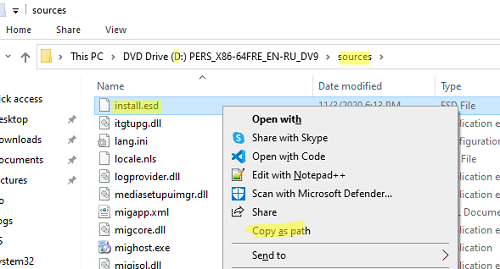
Откройте командную строку с правами администратора и выполните команду (в качестве пути к файлу используйте путь из буфера обмена):
DISM /Get-WimInfo /WimFile:"D:\sources\install.esd"
Перед вами появится список редакций (Education, Home, Enterprise, Pro и т.д.), доступных для установки из этого ISO образа Windows. В нашем примере из этого образа можно установить 5 разных редакций Windows. У каждой редакции есть индекс, по которому можно получить информацию об этом образе.
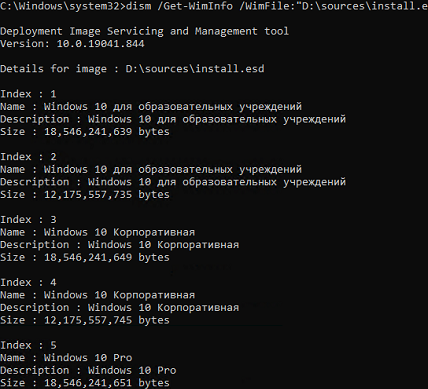
Можно удалить ненужные образы из wim файла по этой инструкции.
Чтобы получить информацию о версии (билде) и доступных языках Windows в WIM/ESD файле в редакции с индексом 1, выполните:
dism /Get-WimInfo /WimFile:"D:\sources\install.esd" /index:1
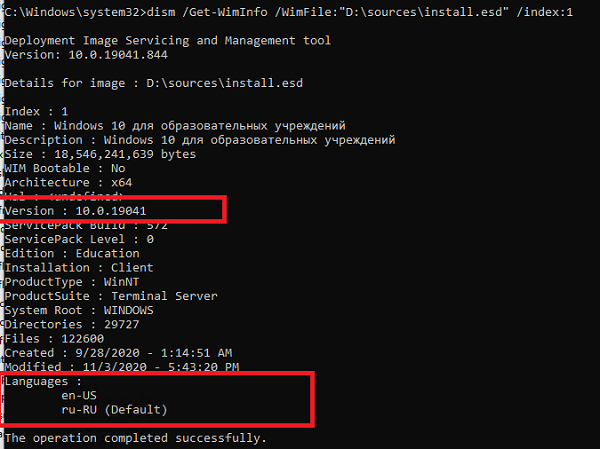
В нашем примере вы определили, что это Windows 10 2004 Education (Version: 10.0.19041), в установочном образе доступны русская (ru-RU) и английские (en-US) версии.
Также вы можете получить всю информацию о версиях и редакциях Windows в установочном ISO файле с помощью простого PowerShell скрипта, который все делает сам.
Задайте путь к ISO файлу:
$imagePath = "C:\Distr\iso\WindowsServer_RTM.iso"
Смонтируйте ISO образ:
$Report = @()
$beforeMount = (Get-Volume).DriveLetter
$mountResult = Mount-DiskImage $imagePath -PassThru
$afterMount = (Get-Volume).DriveLetter
$ImageDrive= "$(($afterMount -join '').replace(($beforeMount -join ''), '')):"
Вы получили букву диска, куда смонтирован образ (буква назначилась автоматически, если нет смотрите как это починить здесь).
Теперь получим информацию о версиях Windows в файле install.wim или install.esd:
$WinImages = Get-windowsimage -ImagePath "$ImageDrive\sources\install.wim”
Foreach ($WinImage in $WinImages)
{
$curImage=Get-WindowsImage -ImagePath "$ImageDrive\sources\install.wim” -Index $WinImage.ImageIndex
$objImage = [PSCustomObject]@{
ImageIndex = $curImage.ImageIndex
ImageName = $curImage.ImageName
Version = $curImage.Version
Languages=$curImage.Languages
Architecture =$curImage.Architecture
}
$Report += $objImage
}
Отмонтировать ISO образ:
Dismount-DiskImage $mountResult.ImagePath
Можно вывести результат в таблицу Out-GridView:
$Report | Out-GridView
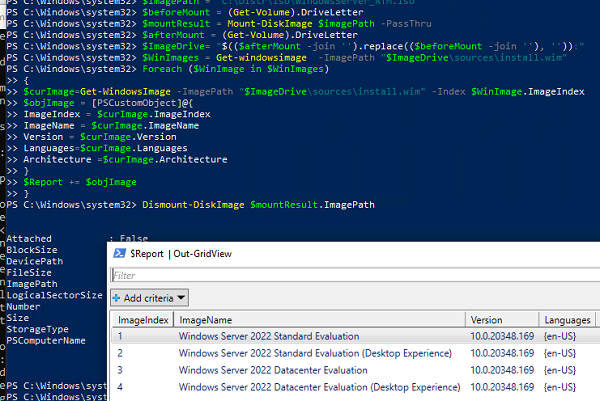
В результате мы получили красивый список образов Windows в ISO файле и их версии. В нашем примере в ISO образе оказался Windows Server 2022 RTM.
Если по той или иной причине вам потребовалось определить номер сборки, установленной на компьютере или ноутбуке Windows 10 или же узнать, какая сборка в имеющемся вами образе или на загрузочной флешке — сделать это достаточно просто. В первом случае достаточно заглянуть в параметры системы (но есть и другие способы), во втором — в файлы дистрибутива Windows 10.
В этой инструкции подробно рассмотрены методы узнать сборку Windows 10 как для уже установленной ОС, так и получить её из файлов установки в образе ISO, на флешке или диске. См. также: Как узнать версию и разрядность Windows 10.
- Как узнать номер сборки Windows 10 на компьютере или ноутбуке
- Как узнать сборку Windows 10 в образе ISO или на флешке
- Видео инструкция
Как посмотреть номер сборки Windows 10 на компьютере или ноутбуке
Если вам необходимо определить номер сборки Windows 10, которая уже установлена на компьютере, сделать это можно следующим способом:
- Зайдите в Пуск — Параметры (или нажмите клавиши Win+I)
- Откройте пункт «Система», а затем в меню слева выберите пункт «О системе».
- Пролистайте страницу до пункта «Характеристики Windows». Здесь вы и увидите необходимые вам данные, включая выпуск (редакцию), версию и номер сборки ОС.
Это не единственный метод для данной ситуации. Существуют и другие встроенные и сторонние способы получить ту же информацию.
К примеру, вы можете нажать клавиши Win+R на клавиатуре, ввести msinfo32 в окно «Выполнить» и нажать Enter. В окне «Сведения о системе» информация о сборке будет указана в разделе «Версия».
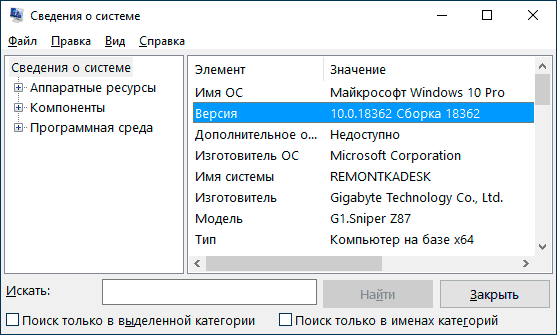
Если нажать те же клавиши, ввести winver и нажать Enter, то появится окно с информацией об установленной системе, включая её сборку, как на скриншоте ниже.
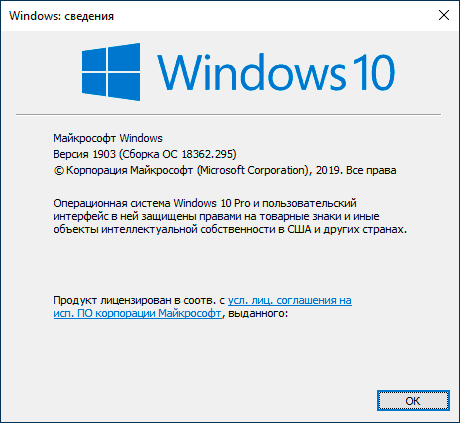
Сторонние программы для просмотра характеристик компьютера также обычно отображают информацию о системе, включая версию, разрядность, сборку.
Как узнать сборку Windows 10 в образе ISO, на загрузочной флешке или диске
Для того, чтобы узнать номер сборки в еще не установленной Windows 10, используйте следующие шаги:
- Подключите ISO образ с Windows 10 (смонтируйте его в системе). В последних версиях ОС это можно сделать, используя пункт «Подключить» в контекстном меню (открывается по правому клику на файлах ISO). Если речь идет о флешке или диске, то также подключите их к компьютеру.
- На подключенном дистрибутиве Windows 10 зайдите в папку sources (если такой папки нет, то x86/sources или x64/sources), и обратите внимание на расширение файла с именем install — это может быть файл install.wim или install.esd, запомните это имя. А еще лучше — удерживая Shift нажмите по имени файла правой кнопкой мыши и выберите пункт «Копировать как путь».
- Запустите командную строку от имени администратора и введите команду, используя свой путь и свое расширение файла install.wim или install.esd (если вы копировали путь, можно просто его вставить):
dism /Get-WimInfo /WimFile:H:\sources\install.wim /index:1
- В результате выполнения команды вы получите сведения о файле установки Windows Строка «Версия» будет содержать и информацию о номере сборки (последние пять цифр).
На этом командную строку можно будет закрыть, образ или дистрибутив с Windows 10 извлечь — сборка Windows 10 нам теперь известна.
Видео инструкция
Если вам требуется какая-то дополнительная информация, касающаяся сборки, задавайте вопросы в комментариях ниже.
Have you downloaded an ISO file, and before making a bootable USB file, want to see what Windows 11/10 edition, build number, language, and other details the ISO image contains? If your answer is positive, then you are reading the correct article. This gearupwindows post will guide you to view the build number, language, and other details from an ISO image file.
Suppose you have downloaded Windows 11/10 ISO images from the Microsoft server or any other website. In that case, it may contain Pro, Home, or any other edition but not included in the file name. You can not find the build number or language of the operating system inside the ISO file. However, using the DISM tool of Windows, you can view these details from the ISO file or even from a USB flash drive.
How to Find Windows 11/10 Version Number in ISO or USB Drive?
To view the details from an ISO file, you need to do the following steps:-
Step 1. Connect the bootable USB flash drive to the PC or mount an ISO image file to a virtual drive.
Double-click on an ISO file to mount it. If some other software is associated by default with ISO files, please perform right-click on the ISO image and select the Mount option from the context menu.
Step 2. Now open File Explorer by pressing the Windows + E hotkey or using other methods, and then navigate to the virtual drive created for your ISO file or open the connected USB drive letter.
Step 3. Open the sources folder and find the file named install.wim, install.swm or install.esd.
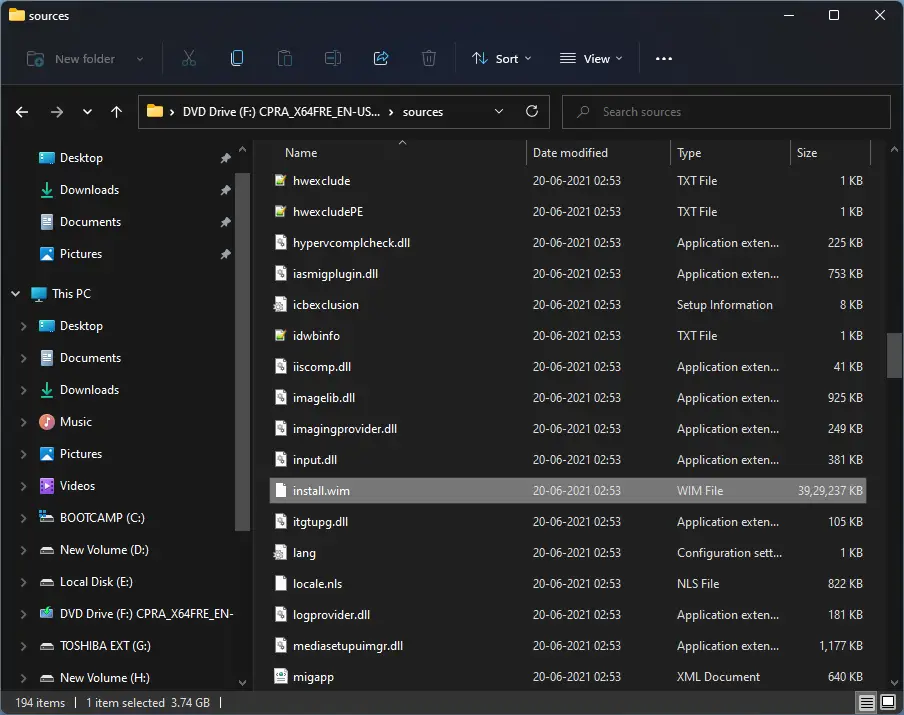
Step 4. Note down the drive letter assigned to the ISO file or USB drive in File Explorer from the address bar. In my case, it is an “F” drive. Now, open Command Prompt as administrator. To do that, open the Run dialog box by pressing Windows + R keys from the keyboard. Type cmd in the Run box and press Ctrl + Shift + Enter from the keyboard.
Step 5. On the prompt, type the following and hit Enter from the keyboard:-
dism /Get-WimInfo /WimFile:X:\sources\install.wim
Note: In the above command, replace “X” with your drive letter. Also, replace install.wim with the install.esd or install.swm, if the install file is different than mine.
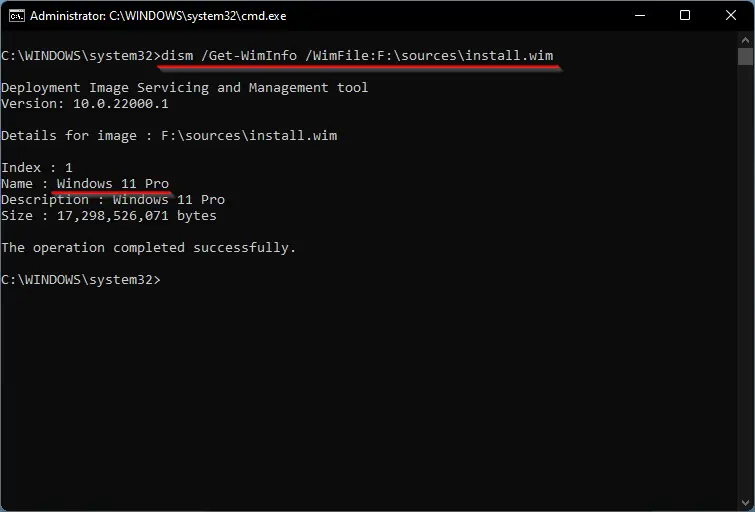
Once you execute the above command, the DISM tool will show the details of the Windows 11/10 version contained in the ISO file. Here, you will also see the index number of all editions available in the ISO image file. If you want to view more details for a specific OS edition, note down its index number and issue the following command:-
dism /Get-WimInfo /WimFile:X:\sources\install.wim /index:<Index number>
Note: Replace X with the drive letter for ISO/USB flash drive on your PC. Now change the <Index number> from the number of indexes you noted in the above output.
For example, in my case dism /Get-WimInfo /WimFile:F:\sources\install.wim /index:1 shows details for the Windows 11 Pro edition in the install.wim file.
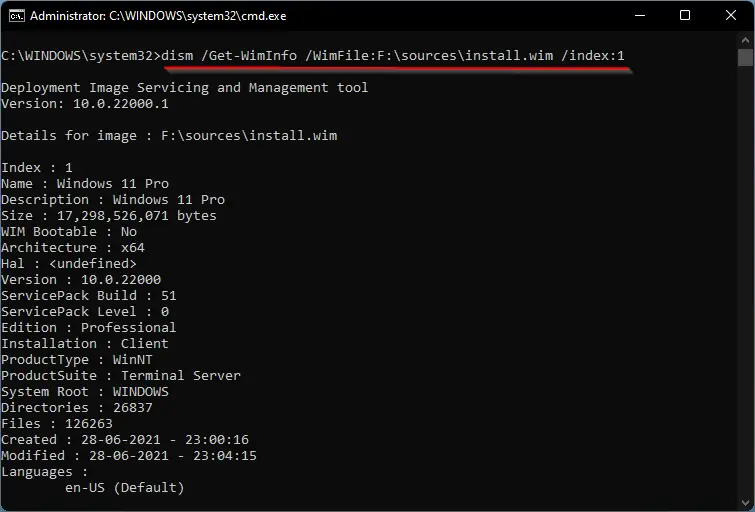
Using the above command, you can view the Windows 11/10 edition, architecture, Version, ServicePack, and date of creation of the ISO file.
Conclusion
In conclusion, if you have downloaded a Windows 11/10 ISO file and want to know the edition, build number, language, and other details contained in the file, you can use the DISM tool of Windows to view them. By following the simple steps outlined in this guide, you can easily view the necessary information from the ISO file or even from a USB flash drive. Knowing this information can help you ensure that you are using the correct edition and version of Windows, which is important for proper functioning and security.
You can learn in this guide if you are unaware of how to check the Windows version on your desktop or laptop computer. As Microsoft pushes many major updates regularly, knowing the build number of your Windows 10/11 OS is very important. That will help you maintain the latest version of Windows on your computer and check the software and hardware compatibility.
Some features and tools only work on a certain version of Windows and build numbers (or later).
The edition indicates what type of Windows 10/11 you have. You can have Windows Home, Professional, and Enterprise. It depends on the purpose and environment you are using the OS. But the Build number indicates whether your system is using the latest final release of Windows OS relevant to you.
As no Service Pack (SP) concept exists in Windows 10 or 11, build number plays a major role here. You can find the Windows version and build number by command prompt and PowerShell, as described below, on the local or remote computer.
1) From Settings App
‘About your PC’ can show the build. Search for ‘About your PC’ and open it.

You can see below system is running on Windows 10 17763 build number.
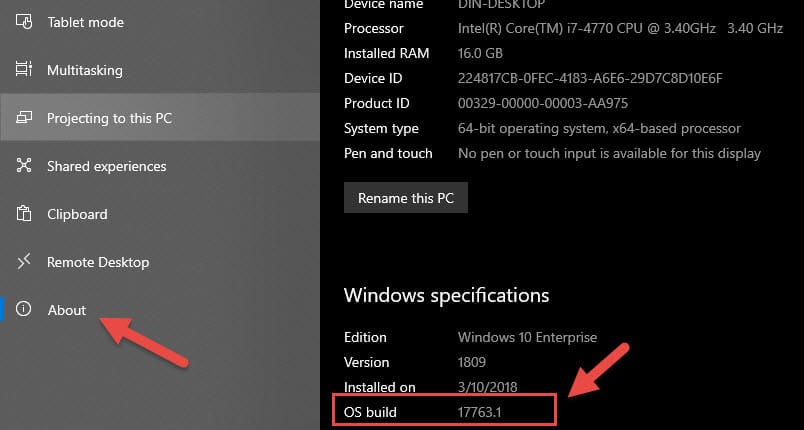
Here is another Windows 11 that shows the version and build number by the About settings app.
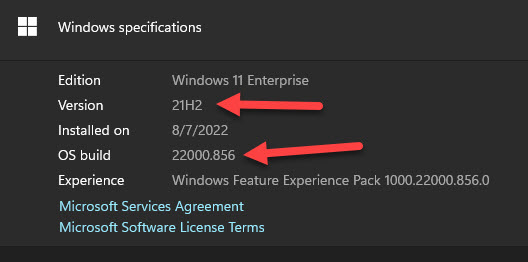
2) From System Information
Another place you can view the build number is System Information. This method will work on any Windows Operating system, like 11, 10, 8.1, Windows 7, and Vista. Search for “System information”.

In System Summary, you can view the version and build of your Windows 10 Operating System.
Windows 11/10 Build number from Command Prompt
Here are a few ways to see the version and the build of Windows 10/11 from the command prompt.
3) Open the command prompt (Type ‘cmd’ in search), then type ‘ver’; it will show the Windows version, which has the build number also.
4) Another method is to get it via system information from the command prompt. Let’s filter the required field only.
Type the below command.
systeminfo | findstr /B /C:”OS Name” /C:”OS Version”

5) The below command will open the dialogue GUI box but in a very useful and attractive way from the command prompt or PowerShell.
Even you can enter ‘winver‘ in the search (or run in older OSs), which can be opened by pressing the Windows key + R.
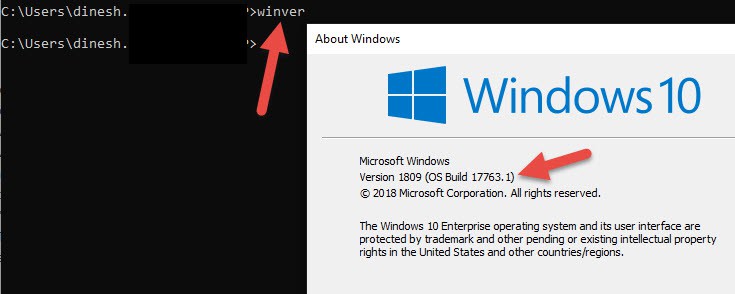
How to Check Windows version and Build by PowerShell Command:
6) According to delftstack, there are several PowerShell commands to get the details of the Windows OS on a computer.
One of the below commands can get the version and build number of the Windows OS.
Get-ComputerInfo | select WindowsProductName, WindowsVersion, OsHardwareAbstractionLayer

We mentioned six steps to check your computer’s Windows version/build number. These commands also work on the Server versions such as Windows 2012 R2, Windows 2016 and 2019/2022. Checking the build number and comparing it with the latest release from Microsoft will ensure that your system is up-to-date with all features and security patches from Microsoft that are highly recommended.
,
If you have downloaded a Windows 10 ISO file in the past and you don’t remember which Windows 10 version, edition or build the ISO file contains, then in this article you ‘ll read the easiest way to find out this information.
When you download and create a Windows installation media in ISO format, using Microsoft’s Media Creation tool, the tool creates a «Windows.ISO» file on your disk, that can be used to create a Windows DVD or USB installation media. The generic name of the ISO file (Windows.iso) doesn’t help you to determine the language, architecture and edition of Windows that you have downloaded.
In this tutorial you will find detailed instructions to identify the Version, Edition, Build, Language and architecture of any Windows installation Media: ISO or USB or DVD. (Applies to Windows 10, 8, 7 OS)
How to Determine the Windows Version, Build or Edition of Windows ISO, DVD or USB.
1. Mount the ISO file to Windows, or attach the Windows Media (USB or DVD) and notice the drive letter in Windows Explorer. (e.g. «X:»)
2. Open Windows Explorer and explore the contents of «sources» directory, to see if it contains a file named «install.wim» or a file named «install.esd»
Case A. If an «install.wim» file exists under the «sources» folder, then open an elevated command prompt (Command Prompt as Administrator) and give the following command to find the Windows version, Edition and Build of the ISO/DVD/USB:
- dism /Get-WimInfo /WimFile:X:\sources\install.wim /index:1
After the execution of the above command, you should see on your screen all the information that you ‘re looking for.
* Notes:
1. Change the drive letter «X» according your case.
2. The Windows 10 Build number, can be retrieved from the «Created» date field (e.g. If the created date is: 7/10/2015 then the build number is the «1507» = Year & Month of Windows 10 release) or by searching the version number (e.g. «10.0.1563») at Wikipedia’s Windows 10 version history article.
3. If you want to find out, if the Windows ISO, USB or DVD image contains contains multiple Windows versions of Windows, just give the above command without the «/Index:1» switch* or change the “/index:1” to “/index:2” or “/index:2” or “/index:3” or “/index:4”
* e.g. dism /Get-WimInfo /WimFile:X:\sources\install.wim

Case B. If an «install.esd» file exists under the «X:\Sources» folder, then open an elevated command prompt and give the following command to find the Windows version, Edition and Build of the ISO/DVD/USB file: *
- dism /Get-WimInfo /WimFile:D:\sources\install.esd /index:1
* Notes:
1. The Windows 10 Build number, can be retrieved from the «Created» date field (e.g. If the created date is: 3/19/2017 then the build number is the «1703» = Year & Month of Windows 10 release) or by searching the version number (e.g. «10.0.1563») at Wikipedia’s Windows 10 version history article.
2. If you want to find out, if the Windows ISO, DVD or USB contains contains multiple versions of Windows, just give the above command without the «/Index:1» switch or change the “/index:1” to “/index:2” or “/index:2” or “/index:3” or “/index:4”
* e.g. dism /Get-WimInfo /WimFile:X:\sources\install.esd

Additional help: If you receive the ‘Error 11’ or the ‘Error 87’, after executing the above «dism /Get-WimInfo» command, then probably you run the command in an older Operating System (e.g. Windows 7) for a newer Windows ‘Install.WIM’ or ‘Install.ESD’ file. (e.g. Windows 10).
That’s it! Let me know if this guide has helped you by leaving your comment about your experience. Please like and share this guide to help others.
If this article was useful for you, please consider supporting us by making a donation. Even $1 can a make a huge difference for us in our effort to continue to help others while keeping this site free:
- Author
- Recent Posts
Konstantinos is the founder and administrator of Wintips.org. Since 1995 he works and provides IT support as a computer and network expert to individuals and large companies. He is specialized in solving problems related to Windows or other Microsoft products (Windows Server, Office, Microsoft 365, etc.).

